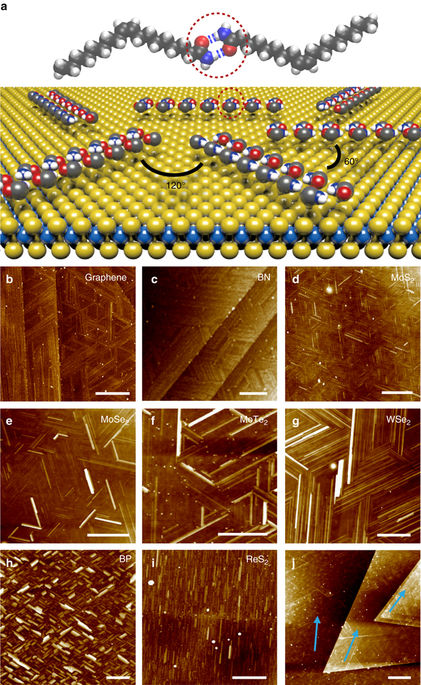当前位置:
X-MOL 学术
›
Nat. Commun.
›
论文详情
Our official English website, www.x-mol.net, welcomes your
feedback! (Note: you will need to create a separate account there.)
Probing the crystallographic orientation of two-dimensional atomic crystals with supramolecular self-assembly.
Nature Communications ( IF 14.7 ) Pub Date : 2017-08-29 , DOI: 10.1038/s41467-017-00329-6
Jinghui Wang , Hongde Yu , Xu Zhou , Xiaozhi Liu , Renjie Zhang , Zhixing Lu , Jingying Zheng , Lin Gu , Kaihui Liu , Dong Wang , Liying Jiao
Nature Communications ( IF 14.7 ) Pub Date : 2017-08-29 , DOI: 10.1038/s41467-017-00329-6
Jinghui Wang , Hongde Yu , Xu Zhou , Xiaozhi Liu , Renjie Zhang , Zhixing Lu , Jingying Zheng , Lin Gu , Kaihui Liu , Dong Wang , Liying Jiao

|
Probing the crystallographic orientation of two-dimensional (2D) materials is essential to understand and engineer their properties. However, the nondestructive identification of the lattice orientations of various 2D materials remains a challenge due to their very thin nature. Here, we identify the crystallographic structures of various 2D atomic crystals using molecules as probes by utilizing orientation-dependent molecule-substrate interactions. We discover that the periodic atomic packing of 2D materials guides oleamide molecules to assemble into quasi-one-dimensional nanoribbons with specific alignments which precisely indicate the lattice orientations of the underlying materials. Using oleamide molecules as probes, we successfully identify the crystallographic orientations of ~12 different 2D materials without degrading their intrinsic properties. Our findings allow for the nondestructive identification of the lattice structure of various 2D atomic crystals and shed light on the functionalization of these 2D materials with supramolecular assembly.Identifying the crystallographic orientations of 2D materials is important, but methods to do so are typically destructive. Here, the authors show that the orientational dependency of self-assembled nanoribbons of oleamide molecules can be used to non-invasively probe the lattice orientations of various 2D substrates.
中文翻译:

用超分子自组装探测二维原子晶体的晶体学取向。
探究二维(2D)材料的晶体学取向对于理解和设计其性能至关重要。然而,由于各种2D材料的非常薄的特性,因此无损识别其2D材料的晶格取向仍然是一个挑战。在这里,我们通过利用分子方向依赖的分子-底物相互作用,以分子为探针来鉴定各种2D原子晶体的晶体结构。我们发现2D材料的周期性原子堆积引导油酰胺分子组装成具有特定排列方式的准一维纳米带,这些排列方式精确地指示了基础材料的晶格取向。使用油酰胺分子作为探针,我们成功地确定了〜12种不同2D材料的晶体学取向,而没有降低它们的固有特性。我们的发现允许对各种2D原子晶体的晶格结构进行非破坏性鉴定,并通过超分子组装阐明这些2D材料的功能化。识别2D材料的晶体学取向很重要,但这样做的方法通常具有破坏性。在这里,作者表明,油酰胺分子自组装纳米带的取向依赖性可用于非侵入性地探测各种2D基底的晶格取向。我们的发现允许对各种2D原子晶体的晶格结构进行非破坏性鉴定,并通过超分子组装阐明这些2D材料的功能化。识别2D材料的晶体学取向很重要,但这样做的方法通常具有破坏性。在这里,作者表明,油酰胺分子自组装纳米带的取向依赖性可用于非侵入性地探测各种2D基底的晶格取向。我们的发现允许对各种2D原子晶体的晶格结构进行非破坏性鉴定,并通过超分子组装阐明这些2D材料的功能化。识别2D材料的晶体学取向很重要,但这样做的方法通常具有破坏性。在这里,作者表明,油酰胺分子自组装纳米带的取向依赖性可用于非侵入性地探测各种2D基底的晶格取向。
更新日期:2017-08-29
中文翻译:

用超分子自组装探测二维原子晶体的晶体学取向。
探究二维(2D)材料的晶体学取向对于理解和设计其性能至关重要。然而,由于各种2D材料的非常薄的特性,因此无损识别其2D材料的晶格取向仍然是一个挑战。在这里,我们通过利用分子方向依赖的分子-底物相互作用,以分子为探针来鉴定各种2D原子晶体的晶体结构。我们发现2D材料的周期性原子堆积引导油酰胺分子组装成具有特定排列方式的准一维纳米带,这些排列方式精确地指示了基础材料的晶格取向。使用油酰胺分子作为探针,我们成功地确定了〜12种不同2D材料的晶体学取向,而没有降低它们的固有特性。我们的发现允许对各种2D原子晶体的晶格结构进行非破坏性鉴定,并通过超分子组装阐明这些2D材料的功能化。识别2D材料的晶体学取向很重要,但这样做的方法通常具有破坏性。在这里,作者表明,油酰胺分子自组装纳米带的取向依赖性可用于非侵入性地探测各种2D基底的晶格取向。我们的发现允许对各种2D原子晶体的晶格结构进行非破坏性鉴定,并通过超分子组装阐明这些2D材料的功能化。识别2D材料的晶体学取向很重要,但这样做的方法通常具有破坏性。在这里,作者表明,油酰胺分子自组装纳米带的取向依赖性可用于非侵入性地探测各种2D基底的晶格取向。我们的发现允许对各种2D原子晶体的晶格结构进行非破坏性鉴定,并通过超分子组装阐明这些2D材料的功能化。识别2D材料的晶体学取向很重要,但这样做的方法通常具有破坏性。在这里,作者表明,油酰胺分子自组装纳米带的取向依赖性可用于非侵入性地探测各种2D基底的晶格取向。

































 京公网安备 11010802027423号
京公网安备 11010802027423号